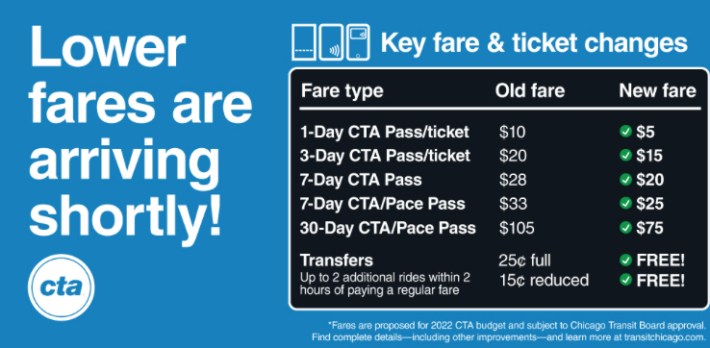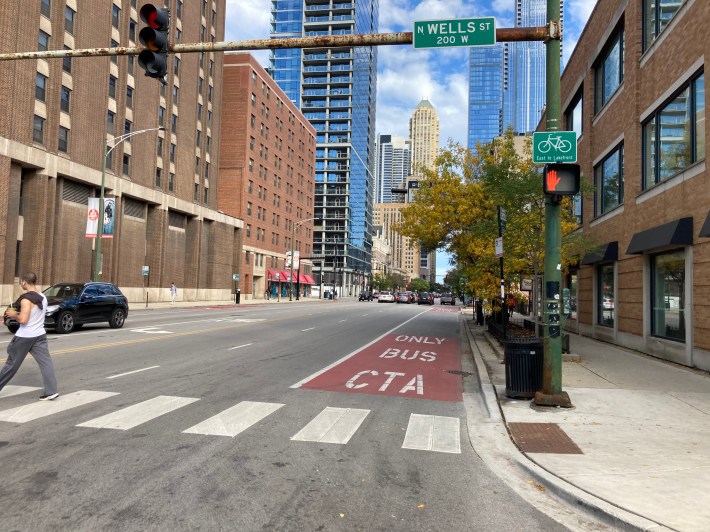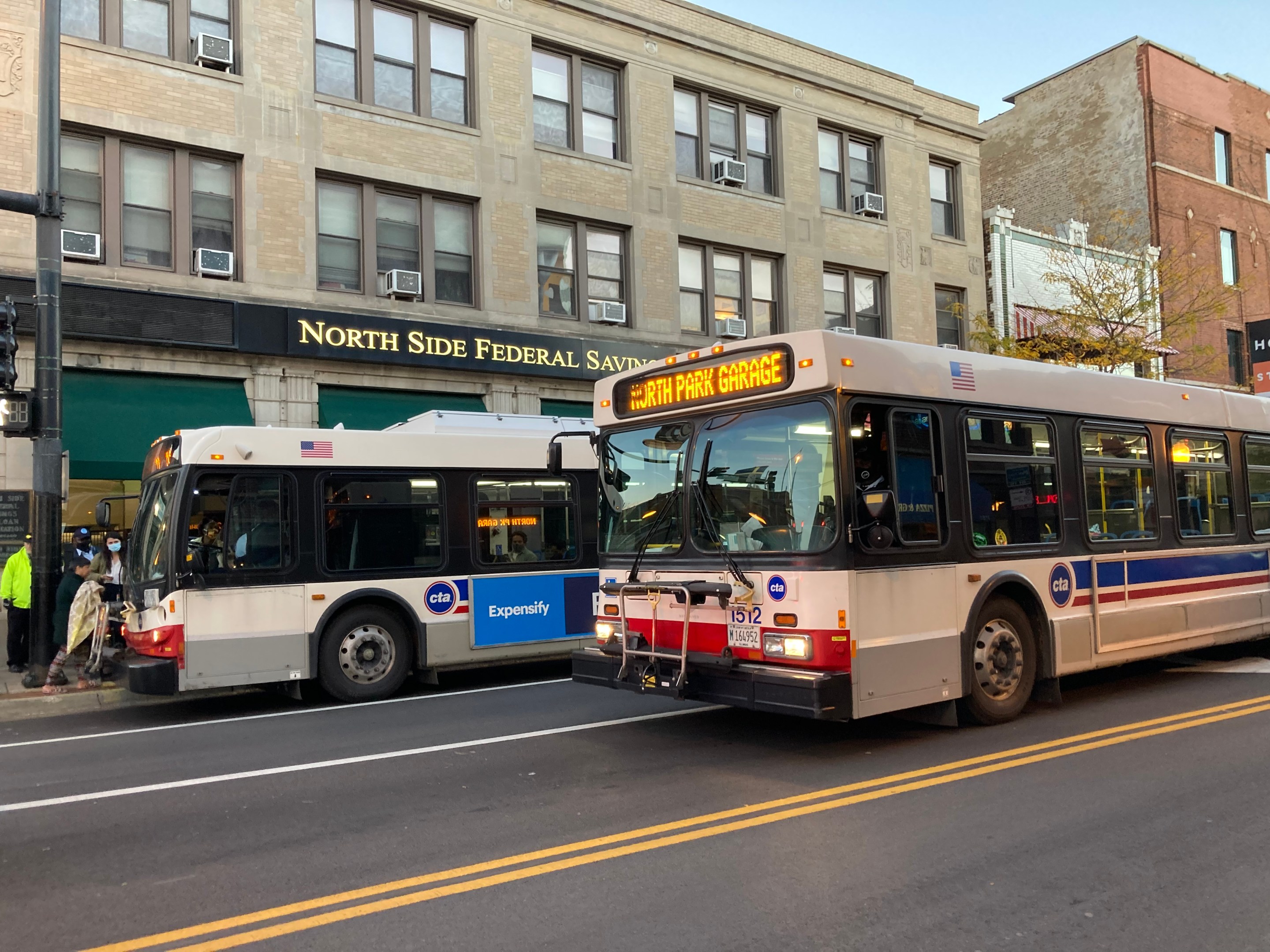The CTA‘s 2022 budget calls for the system's biggest fare chance since 2013, slashing all pass prices and getting riding of the 25-cent charge for the first transfer.
The budget calls for making temporary fare reductions for 1-Day, 3-Day and 7-Day passes permanent, while also reducing the prices for CTA/Pace 30-Day passes from $105 to $75 and reducing the price of CTA/Pace 7-Day Pass from $33 to $25. The budget also mentions potentially making other changes to simplify transfers between the CTA, Metra and Pace, as well as making a 30-Day Pass good for a specific month rather than 30 days from when it’s activated, although those changes would be contingent on the approval of the other transit agencies’ respective boards of directors.
On the capital projects front, the budget largely continues the existing major projects, including Red Line improvements and ongoing efforts to make more ‘L’ stations ADA-compliant. It calls for buying more electric buses and working with the Chicago Department of Transportation to find ways to speed up buses on some of the city’s busiest corridors. The CTA will establish the new Office of Equity and Inclusion to “support and expand upon the CTA’s already industry-leading efforts toward promoting opportunity, employment, training, economic development, and other aspects of the agency’s commitment to equity and inclusion.” The budget doesn’t elaborate on it beyond that.
Throughout the pandemic, the CTA has been the only Chicago area agency not to suspend routes or reduce service frequencies (at least on paper – transit riders have reported unusually long waits between buses and trains recently.). The agency got the lion’s share of the funding for Chicagoland transit from the last two federal stimulus packages. But unlike Metra and Pace, the CTA won’t have enough stimulus funding to cover pandemic-related losses for next year. By the start of 2022, the agency is expected to spend the last of the $817.5 million it got through the Coronavirus Aid, Relief and Economic Security (CARES) Act, and spend the $299 million it has left over from the $361.3 million it got through the Coronavirus Response and Relief Supplemental Appropriations (CRRSA) Act. While it third stimulus package, the American Rescue Plan Act, allocated $1.5 billion for the region (including Northwest Indiana and Southeast Wisconsin), the RTA isn’t expected to decide on how much of that money the CTA, Metra and Pace will get until December.
Fare Changes
During this summer, the CTA lowered the costs of 1-Day, 3-Day, and 7-Day passes as a way to encourage riders to use transit. The budget would make those reductions permanent, cutting the $10 1-Day pass to $5, the $20 3-Day Pass to $15, and the $28 7-Day Pass to $20.

Under the current face system, riders get two transfers that can be used within 120 minutes for the first ride. The first one costs an additional 25 cents, while the second one is free. Pace transfers work the same way, except their free for the first transfer is 30 cents (except on Local Fixed routes – routes that serve Aurora, Elgin, Joliet and Waukegan – where the transfers are free). When transferring between two systems, the first transfer costs 25 cents. Eliminating the transfer charge would bring CTA in line with Pace local routes, just without geographical restrictions, and make Pace transfers more expensive by comparison.
Even with the reduced prices, the CTA expects to bring in $293.9 million, which is $45.6 million more than what it budgeted for 2021 and $53.6 million, or 22.3 percent more than what it currently forecasts to actually take in by the end of this year. “The increase in farebox revenue is due to higher projected ridership as the local economy continues to reopen and COVID-19 restrictions that were in place for most of 2020 - 2021 are lifted,” the budget document states.
Under the current fare system, CTA passes are only good on CTA bus and ‘L’ routes unless explicitly specified otherwise. Similarly, Pace has its own $30 30-Day Pass and a Campus Connection college student pass. The budget documents mentions that the CTA “plan[s] to work with Pace to integrate 1 and 3 Day passes with the suburban bus agency.”
Interestingly, the budget doesn’t mention Pace’s $140 30-Day Premium Route pass, which is good for regular and premium routes (routes where the fares are $5 instead of regular $2 fares). The passes are mostly used for I-55 Express routes, but because they don’t work on the CTA, they don’t have much transfer value outside Pace.
(The CTA/Pace 30-Day passes sort of work on the premium routes – Ventra acts as if you paid half of the fare and charges the rest against the account balance.)
Metra's Link-Up Pass is basically an extra for a monthly pass. Riders can pay extra $55 to be able to use it on Pace and CTA routes during rush hours. The CTA is proposing lowering the price to $30, bringing it in line with the Pace/Metra-only Pace PlusBus Pass, and removing the time limits on use on CTA buses and trains. If this is accomplished, we may finally get something that has eluded Chicago area transit planners for decade: a universal CTA/Metra/Pace pass.
According to Bloomberg CityLab, Alex Perez, the advocacy manager for the Active Transportation Alliance, called the pass price reductions “a huge win for racial and transportation equity. We’re happy to see Chicago take away that cost barrier for low-income people who are going to benefit the most. But it’s also going to be a big win for CTA due to increased ridership.”
Capital Projects
The proposed CTA budget allocates $345 million toward the currently in-progress renovation of the section of the Red and Purple lines between Lawrence and Bryn Mawr, part of the Red and Purple Modernization project. Another $358 million would go toward the long-awaited South Red Line Extension form 95th to 130th streets. So far, the money is still being spent on prep work, finishing up the Environmental Impact Study and beginning the engineering study.
$23 million would go towards ongoing station rehabilitation, most notably, making the Austin/Lake Green Line station wheelchair-accessible. $17 million would go to the Bus Priority Zone program, a collaboration between the CTA and CDOT where the two agencies work together to figure out ways to “improve speed and reliability on the major bus corridors.”

The CTA would spend $287 million over the next five years to replace up to 500 buses, including buying up to 70 electric buses. The charging infrastructure would be built at the 103rd Street garage, which serves a number of South Side routes. The CTA expects to have a total of 25 electric buses in service by the end of 2022.
As part of the Rebuild Illinois state capital plan, the CTA received $178 million for improvements to the Blue Line’s Forest Park branch, including track and traction power upgrades, and “updates to the Racine station to ensure customer accessibility.” It should be noted that both Racine and Loomis entrances use ramps, but the work could potentially include turnstile upgrades.





